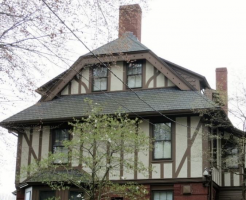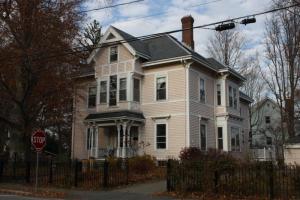Stick Style: 1860-1890
Stick Style: 1860-1890
As the name suggests, it is identified by its diagonal, vertical and horizontal applied stickwork that often imitates the half-timbering of medieval structures. Other commonly used details of the style include the use of jerkinhead (clipped gable) roofs, incised detailing and decorative wood trusses in gables.
Examples Found in Belmont:

William E. Stowe House, 1880 | 560 Concord Ave.
The Stowe House is significant as an excellent example of the Stick Style and the only example of the style that remains extant on Belmont Hill. The contrasting materials include a brick and clapboarded first floor and stuccoed second and third stories with an overlay of vertical, horizontal and diagonal stickwork. The steeply pitched roof is punctuated by brick chimneys, shingled shed dormers and gables – both conventional and clipped.
Stowe, a Boston cotton merchant, was married to the former Agnes Homer (1843-1909) and the house was built to the west of the home (no longer extant) of her parents, William Flagg Homer (d. 1883) and his wife Adeline Homer.

Richardson Swift House, 1883 | 104 School St.
The oldest house in the Belmont Park neighborhood, 104 School Street is a good example of the Stick Style. Typical of the style the house is sheathed in wood clapboards with applied stick work which is used for ornament rather than to express structure. There is a wide variety of wood trim including turned porch posts and turned balustrades, fancy brackets at the tops of the porch posts, at the tops of the cornerboards, decorating bay windows and overhangs and supporting canopies over the first floor windows. Jigsawn trim is located below the windows and raised wooden knobs decorate the gables and second floor window lintels.


